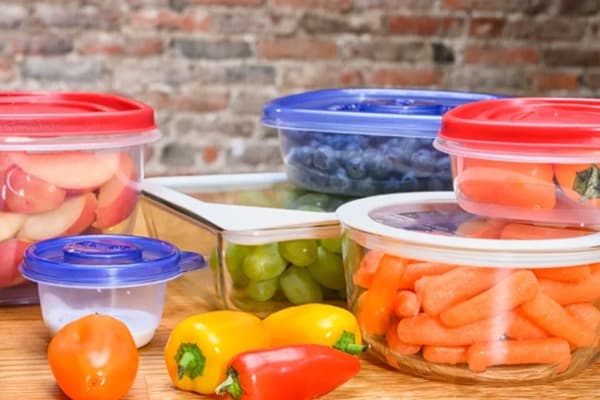When it comes to food storage, the type of container you use can have a significant impact on the health and longevity of your food. From preventing contamination to ensuring food stays fresh for longer, choosing the right storage container is essential. Among the most common options are plastic containers, glass jars, metal tins, and ceramic dishes. But what is the healthiest container to store food in? In this article, we’ll explore the pros and cons of different food storage options and focus on why some containers might be healthier than others.
The Risks of Plastic Containers
Plastic containers are widely used for food storage because they are affordable, lightweight, and durable. However, not all plastics are created equal, and some may pose risks to human health, especially when used for storing hot or fatty foods.
-
BPA (Bisphenol A): Some plastic containers are made with BPA, a chemical that has been linked to various health issues, including hormonal disruptions, developmental problems in children, and increased risk of cancer. Although many manufacturers now offer BPA-free plastic containers, research has shown that even BPA-free plastics may still contain other chemicals that can leach into food.
-
Phthalates: These are another group of chemicals used to make plastics more flexible. Like BPA, they can leach into food and have been associated with health risks such as reproductive issues and increased risk of obesity.
-
Microplastics: Over time, plastic containers can degrade, especially when exposed to heat or sunlight. This breakdown leads to the formation of microplastics, which can then be ingested. Recent studies suggest that microplastics may have adverse effects on human health, though more research is needed.

Healthier Alternatives to Plastic Containers
1. Glass Containers
Glass containers are often regarded as one of the healthiest options for food storage. Unlike plastic, glass doesn’t leach harmful chemicals into food, making it a safe choice. Here are the main benefits:
-
Non-toxic and chemical-free: Glass does not contain BPA, phthalates, or other harmful chemicals, ensuring that your food stays free of contaminants.
-
Does not retain odors or stains: Glass is resistant to absorbing odors or colors from the food, unlike plastic which can retain stains from sauces, oils, or acidic foods.
-
Can handle high temperatures: Glass containers can safely be used in the oven and microwave without the risk of melting or leaching harmful substances.
However, glass containers are heavier and more prone to breaking than plastic, making them less portable or suitable for certain types of food storage.
2. Stainless Steel Containers
Stainless steel containers are another excellent option for food storage. They offer many of the same benefits as glass but with added durability and versatility.
-
Non-reactive: Stainless steel does not react with acidic or alkaline foods, which means it will not alter the flavor or quality of your food.
-
Long-lasting and durable: Stainless steel is more robust than glass, and unlike plastic, it will not crack or break. This makes it ideal for on-the-go storage or for long-term storage in the pantry.
-
No chemical leaching: Just like glass, stainless steel does not contain harmful chemicals, so it won’t release toxins into your food.
While stainless steel containers are excellent for dry foods or refrigerated items, they are generally not microwave-safe.
3. Ceramic Containers
Ceramic containers are often made from natural clay and glazed with non-toxic materials, making them another safe option for storing food.
-
Non-toxic: High-quality ceramics that are free from harmful chemicals, such as lead and cadmium, are safe to use for food storage.
-
Good insulation: Ceramic provides natural insulation, which can help keep foods warm or cold for longer periods.
-
Aesthetic appeal: Ceramic containers are often attractive and come in a variety of designs, making them great for serving food directly from the storage container.
Like glass, ceramics are heavy and can break easily, which may make them impractical for everyday use in some situations.
Why Not Use Plastic Containers?
Despite their widespread use, plastic containers are not always the healthiest choice. While convenient and inexpensive, plastic containers have notable downsides that can affect both your food and your health.
-
Chemical leaching: Even BPA-free plastic can contain other potentially harmful chemicals that can leach into food, especially when exposed to heat or when the container is scratched.
-
Environmental impact: Plastic is not biodegradable and contributes significantly to pollution. Additionally, plastic production is energy-intensive and can release harmful pollutants into the environment.
For these reasons, many health-conscious individuals and environmentally aware consumers are moving away from plastic and choosing alternatives like glass, stainless steel, and ceramics.
Which Container Should You Choose?
When deciding on the healthiest container to store food in, glass and stainless steel are the top contenders, with both providing a safe, non-toxic option for storing your food. If you need portability and durability, stainless steel is an excellent choice. For food that will be stored in the refrigerator or served at the table, glass is a great option due to its clarity and non-reactivity.
If you prefer an aesthetic touch, ceramic containers provide both beauty and function, as long as they are free from harmful chemicals.
Conclusion
In conclusion, while plastic containers are convenient and affordable, they may not be the healthiest choice for storing food due to the risk of chemical leaching. Glass and stainless steel containers are generally regarded as the healthiest and most durable alternatives, providing safe and toxin-free storage for your food. When choosing a container, consider factors such as convenience, durability, and the nature of the food you’re storing. By switching to healthier options, you can ensure that your food stays fresh, safe, and free from harmful contaminants.
Post time: 08-28-2025



